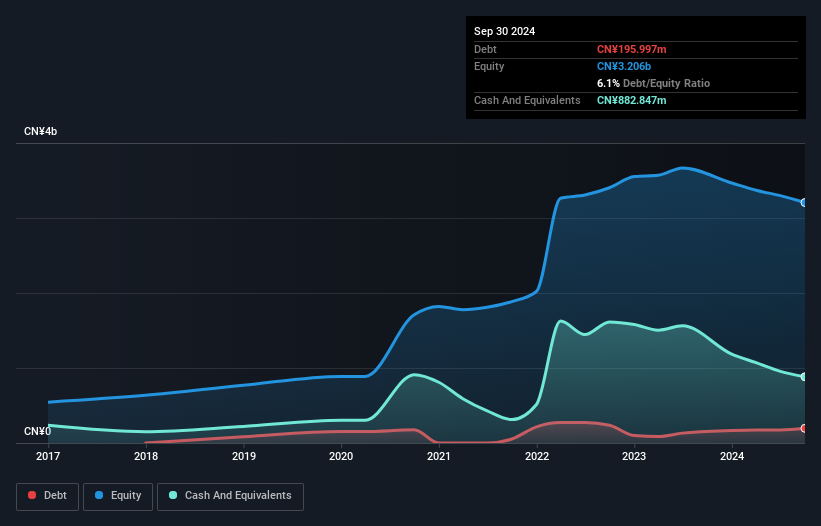- China
- /
- Professional Services
- /
- SZSE:300887
Pony Testing (SZSE:300887) Has Debt But No Earnings; Should You Worry?
Warren Buffett famously said, 'Volatility is far from synonymous with risk.' So it might be obvious that you need to consider debt, when you think about how risky any given stock is, because too much debt can sink a company. We note that Pony Testing Co., Ltd. (SZSE:300887) does have debt on its balance sheet. But is this debt a concern to shareholders?
Why Does Debt Bring Risk?
Debt and other liabilities become risky for a business when it cannot easily fulfill those obligations, either with free cash flow or by raising capital at an attractive price. In the worst case scenario, a company can go bankrupt if it cannot pay its creditors. However, a more frequent (but still costly) occurrence is where a company must issue shares at bargain-basement prices, permanently diluting shareholders, just to shore up its balance sheet. By replacing dilution, though, debt can be an extremely good tool for businesses that need capital to invest in growth at high rates of return. The first thing to do when considering how much debt a business uses is to look at its cash and debt together.
View our latest analysis for Pony Testing
How Much Debt Does Pony Testing Carry?
The image below, which you can click on for greater detail, shows that at September 2024 Pony Testing had debt of CN¥196.0m, up from CN¥167.1m in one year. However, it does have CN¥882.8m in cash offsetting this, leading to net cash of CN¥686.9m.

A Look At Pony Testing's Liabilities
The latest balance sheet data shows that Pony Testing had liabilities of CN¥688.2m due within a year, and liabilities of CN¥63.3m falling due after that. On the other hand, it had cash of CN¥882.8m and CN¥1.02b worth of receivables due within a year. So it can boast CN¥1.16b more liquid assets than total liabilities.
This surplus suggests that Pony Testing is using debt in a way that is appears to be both safe and conservative. Due to its strong net asset position, it is not likely to face issues with its lenders. Succinctly put, Pony Testing boasts net cash, so it's fair to say it does not have a heavy debt load! When analysing debt levels, the balance sheet is the obvious place to start. But it is future earnings, more than anything, that will determine Pony Testing's ability to maintain a healthy balance sheet going forward. So if you're focused on the future you can check out this free report showing analyst profit forecasts.
Over 12 months, Pony Testing made a loss at the EBIT level, and saw its revenue drop to CN¥1.8b, which is a fall of 35%. To be frank that doesn't bode well.
So How Risky Is Pony Testing?
Statistically speaking companies that lose money are riskier than those that make money. And we do note that Pony Testing had an earnings before interest and tax (EBIT) loss, over the last year. Indeed, in that time it burnt through CN¥134m of cash and made a loss of CN¥232m. Given it only has net cash of CN¥686.9m, the company may need to raise more capital if it doesn't reach break-even soon. Even though its balance sheet seems sufficiently liquid, debt always makes us a little nervous if a company doesn't produce free cash flow regularly. When analysing debt levels, the balance sheet is the obvious place to start. However, not all investment risk resides within the balance sheet - far from it. These risks can be hard to spot. Every company has them, and we've spotted 1 warning sign for Pony Testing you should know about.
When all is said and done, sometimes its easier to focus on companies that don't even need debt. Readers can access a list of growth stocks with zero net debt 100% free, right now.
New: Manage All Your Stock Portfolios in One Place
We've created the ultimate portfolio companion for stock investors, and it's free.
• Connect an unlimited number of Portfolios and see your total in one currency
• Be alerted to new Warning Signs or Risks via email or mobile
• Track the Fair Value of your stocks
Have feedback on this article? Concerned about the content? Get in touch with us directly. Alternatively, email editorial-team (at) simplywallst.com.
This article by Simply Wall St is general in nature. We provide commentary based on historical data and analyst forecasts only using an unbiased methodology and our articles are not intended to be financial advice. It does not constitute a recommendation to buy or sell any stock, and does not take account of your objectives, or your financial situation. We aim to bring you long-term focused analysis driven by fundamental data. Note that our analysis may not factor in the latest price-sensitive company announcements or qualitative material. Simply Wall St has no position in any stocks mentioned.
About SZSE:300887
Pony Testing
Operates as a testing, inspecting, and certification company in China.
Excellent balance sheet with reasonable growth potential.
Market Insights
Community Narratives





